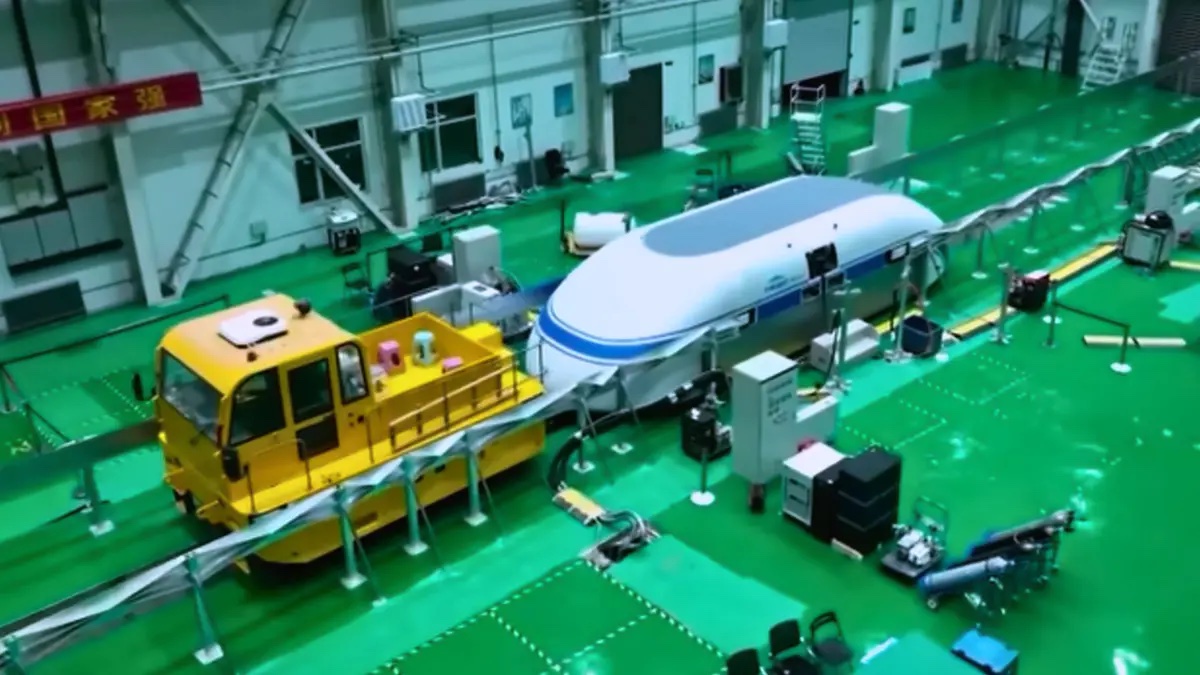Back in 2013, Elon Musk introduced the world to the Hyperloop, a futuristic transportation system that promised to shuttle passengers between cities at mind-blowing speeds of up to 1,000 km/h (621 mph) through near-vacuum tubes. Despite Musk’s groundbreaking successes with electric cars and reusable rockets, the Hyperloop concept faced significant engineering and financial challenges. Issues like airtight seals, massive temperature fluctuations, and the complexities of integrating high-speed maglev technology into practical infrastructure kept the Hyperloop grounded. However, a remarkable test project in China has now shown that a Hyperloop-like future may indeed be within reach.
In 2024, Chinese engineers successfully constructed a 2-kilometer (1.2-mile) test line in Yanggao County, Shanxi province, to explore near-vacuum maglev technology. Led by master engineer Xu Shengqiao and a team from the China Railway Engineering Consulting Group (CREC), the project aimed to test the feasibility of a near-vacuum transport system similar to Musk’s original Hyperloop concept.
Unlike Musk’s original plan, which relied on large steel tubes prone to leaks and extreme drag at high speeds, CREC’s design used a combination of steel and concrete to overcome these challenges. The team created a steel-concrete tube structure sealed with epoxy-coated rebar and corrugated steel expansion joints, designed to withstand harsh conditions ranging from freezing winters to sweltering 45°C (113°F) summers. This innovation ensures the tubes remain airtight while significantly reducing energy loss—an issue that plagued previous Hyperloop prototypes.
One of the most critical hurdles the Chinese engineers faced was the materials used in the construction of the vacuum tubes. Traditional steel reinforcements in concrete can warp or crack when subjected to near-vacuum conditions, while standard concrete risks crumbling as internal air pressure approaches zero. CREC’s team found solutions by turning to basalt-fiber concretes, glass-fiber reinforcements, and pre-vacuum curing processes to address these material weaknesses.
In a significant milestone on July 22, 2024, the team successfully tested a levitating vehicle cruising along a maglev track in a partial vacuum. The system used laser-guided sensors and AI-driven magnetic dampers to maintain stability while distributed vacuum pumps balanced the pressure inside the tube. The vehicle was supported by a vacuum-sealed corridor that allowed it to travel at high speeds, overcoming the intense heat and pressure challenges that Musk’s team had struggled with.
Safety features, such as emergency airlocks and pressure-resistant passenger cabins, were also incorporated, ensuring that the system could handle potential risks associated with vacuum tube travel. These innovations addressed the same safety concerns that had previously stalled Hyperloop development.
With the successful completion of its 2-kilometer test bed, CREC has developed a blueprint for expanding the system far beyond its current scope. The use of prefabricated tube segments significantly reduces costs—up to 60% lower than traditional all-steel piping—making the system more scalable for future development.
However, turning this test project into a commercially viable system would require a massive investment, potentially in the hundreds of billions of yuan. Challenges such as thermal expansion over long distances and the design of a swift, reliable emergency response system still need to be addressed.
China is leveraging its extensive experience with high-speed rail to address these hurdles. The country’s history of automated welding, laser-guided surveying, and millimeter-level tolerances in rail systems has already set global records. These advanced engineering practices, along with developments in superconducting materials and vacuum technology, may give China a unique advantage in perfecting near-vacuum travel at unprecedented speeds.
For Elon Musk, the failure of the Hyperloop highlighted the immense complexity and cost of developing a vacuum tube transportation system. Yet, China’s recent achievement stands as a hopeful new chapter in the Hyperloop saga. While it remains uncertain whether this test project will eventually evolve into a fully commercial venture, one thing is clear: China has revived Musk’s abandoned dream, bringing a level of determination and innovation that could potentially turn near-supersonic ground travel into a reality.
As technology progresses and challenges continue to be overcome, the possibility of a Hyperloop-like future may no longer be confined to science fiction. China’s bold leap into the realm of near-vacuum maglev transport could be the first step toward transforming this ambitious vision into a global transportation revolution.
By Impact Lab


